Top 10 Things to Do in Rome
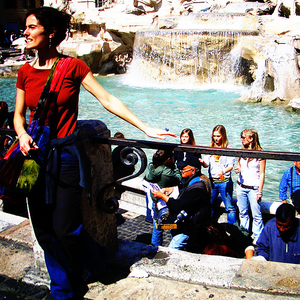 Once upon a time I asked readers which city in Italy they’d spend a week in, if they had to choose only one. Overwhelmingly, you chose Rome – so I figured it’s about time I got around to posting my list of the Top 10 Things to Do in Rome.
Once upon a time I asked readers which city in Italy they’d spend a week in, if they had to choose only one. Overwhelmingly, you chose Rome – so I figured it’s about time I got around to posting my list of the Top 10 Things to Do in Rome.
Before I get to the list, however, a note about why I put off doing this list for so long. I compiled similar lists for a few other cities in Italy with relative ease (only one of them gave me fits), but every time I thought about trying to squish The Eternal City into 10 must-do things, I got gunshy. I mean, really – the title of “Eternal City” has always made me think “you’d need an eternity to see everything here.”
And while that remains true to an extent, it’s also true that there are some big-time sights that everyone expects to check off their lists when they visit Rome. Some of them live up to their reputation, while others (in my opinion) can wait for future visits. Certainly, the more people you ask what you should see in Rome, the more varied your to-do list is going to be – so if my suggestions don’t match everyone else’s, don’t be surprised.
Top 10 Things to Do in Rome (According to Jessica)
- Hang Out in the Pantheon
 The Pantheon in Rome is, hands down, my favorite building in the city. In a city that is simply replete with important historic buildings and monuments, the Pantheon still manages to stand out. Because while the Forum requires a spectacular imagination (or a spectacular guide, or both) and even the Colosseum is a shell of its former self, the Pantheon looks today – inside and out – much the way it has for nearly 2,000 years. Those marble floors you’re walking on? Yeah, people have been walking on them for two thousand years. The building’s been in constant use for two thousand years. Sun (or rain, depending on when you visit) has been streaming through the oculus for… Well, you get my point. If book history leaves you yawning, give real-life history a try. This is the stuff that gives me chills. And incidentally, another reason I suggest the Pantheon before the Forum and Colosseum is so you can see what a Roman building looked like back in the day – which can give you a better feel for what the ruins you’ll check out in #2 and #3 once looked like.
The Pantheon in Rome is, hands down, my favorite building in the city. In a city that is simply replete with important historic buildings and monuments, the Pantheon still manages to stand out. Because while the Forum requires a spectacular imagination (or a spectacular guide, or both) and even the Colosseum is a shell of its former self, the Pantheon looks today – inside and out – much the way it has for nearly 2,000 years. Those marble floors you’re walking on? Yeah, people have been walking on them for two thousand years. The building’s been in constant use for two thousand years. Sun (or rain, depending on when you visit) has been streaming through the oculus for… Well, you get my point. If book history leaves you yawning, give real-life history a try. This is the stuff that gives me chills. And incidentally, another reason I suggest the Pantheon before the Forum and Colosseum is so you can see what a Roman building looked like back in the day – which can give you a better feel for what the ruins you’ll check out in #2 and #3 once looked like. - Walk Through History in the Roman Forum
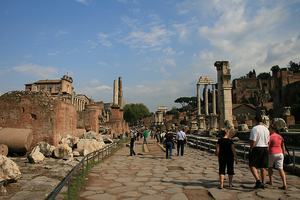 As mentioned above, being in truly historic spaces really gets my blood going, so an easy #2 on my list here is to walk on the cobbled streets of the Roman Forum. If I’m honest, even though I love thinking about all the feet that have walked on those cobblestones (my inner dialogue tends to be, “did Caesar walk on this one? how about this one?“), the Forum still pales in comparison to the Pantheon for me. The ruins are so ruined in most cases that it’s impossible to really see the grandeur of what used to be. Which is why I advise a stop at the Pantheon first, so you have a better idea of what all of these piles of stones used to look like. And be sure to pick up a copy of “Rome: Past & Present,” with its plastic overlays of what the Forum looked like in ancient times, before you go in. A good tour guide helps immensely, too. But even though I prefer the Pantheon, just knowing that the streets of the small area of the Forum were the epicenter of the massive Roman Empire is enough to make me say, “Wow.” (And for a commanding view over the whole Forum, take the Rome from the Sky elevator to the top of the Vittorio Emanuele II Monument next door!)
As mentioned above, being in truly historic spaces really gets my blood going, so an easy #2 on my list here is to walk on the cobbled streets of the Roman Forum. If I’m honest, even though I love thinking about all the feet that have walked on those cobblestones (my inner dialogue tends to be, “did Caesar walk on this one? how about this one?“), the Forum still pales in comparison to the Pantheon for me. The ruins are so ruined in most cases that it’s impossible to really see the grandeur of what used to be. Which is why I advise a stop at the Pantheon first, so you have a better idea of what all of these piles of stones used to look like. And be sure to pick up a copy of “Rome: Past & Present,” with its plastic overlays of what the Forum looked like in ancient times, before you go in. A good tour guide helps immensely, too. But even though I prefer the Pantheon, just knowing that the streets of the small area of the Forum were the epicenter of the massive Roman Empire is enough to make me say, “Wow.” (And for a commanding view over the whole Forum, take the Rome from the Sky elevator to the top of the Vittorio Emanuele II Monument next door!) - Circle the Colosseum, Inside & Out
 I’ll confess that on my first draft of this list, I actually left Rome’s most famous monument, the Colosseum, off. I know, I know. But hear me out – back when I first visited, the lines were atrocious, the gauntlet of sweaty men dressed in plastic gladiator attire pressuring you to pay for a photo with them was annoying, and the interior of the Colosseum itself was (I thought) kind of disappointing after all the build-up. But the truth is that it’s the largest remaining Roman-era amphitheatre anywhere, and although the inside was used as something of a rock quarry for later building projects (if you think it looks torn apart inside, that’s because it was), it’s still a fascinating look back at one very important (though gruesome) aspect of life in the ancient capital. You’ll be well-served by a good guide (either a book, an audio-guide, or a person) to explain things, and you can avoid the worst of the ticket lines by buying a combo ticket – good for the Forum and the Palatine Hill as well – at one of those other two locations.
I’ll confess that on my first draft of this list, I actually left Rome’s most famous monument, the Colosseum, off. I know, I know. But hear me out – back when I first visited, the lines were atrocious, the gauntlet of sweaty men dressed in plastic gladiator attire pressuring you to pay for a photo with them was annoying, and the interior of the Colosseum itself was (I thought) kind of disappointing after all the build-up. But the truth is that it’s the largest remaining Roman-era amphitheatre anywhere, and although the inside was used as something of a rock quarry for later building projects (if you think it looks torn apart inside, that’s because it was), it’s still a fascinating look back at one very important (though gruesome) aspect of life in the ancient capital. You’ll be well-served by a good guide (either a book, an audio-guide, or a person) to explain things, and you can avoid the worst of the ticket lines by buying a combo ticket – good for the Forum and the Palatine Hill as well – at one of those other two locations. - Get a Tour of Vatican City
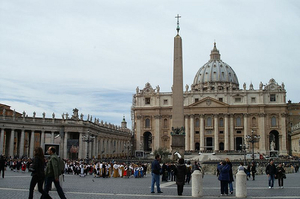 While Vatican City is technically its own independent city-state, no one visits Vatican City on its own without visiting Rome as well. For most travelers, touring the Vatican is one day out of a trip to Rome, and that’s exactly what I suggest when people ask me how much time they should spend in Vatican City – but in addition to allotting a day for the Vatican, I also highly recommend signing on to a good guided tour of the Vatican. This will not only help you navigate the maze of the Vatican Museums (and make sure you don’t miss any of the truly important stuff), a good guide will also help you understand the context of what you’re seeing as well. And whether or not you’re Catholic, a visit to St. Peter’s Basilica is made infinitely more interesting when you know what it is you’re looking at. (Oh, and if you want to see something that most tourists don’t even know about, then check out the secret Vatican Scavi tour!)
While Vatican City is technically its own independent city-state, no one visits Vatican City on its own without visiting Rome as well. For most travelers, touring the Vatican is one day out of a trip to Rome, and that’s exactly what I suggest when people ask me how much time they should spend in Vatican City – but in addition to allotting a day for the Vatican, I also highly recommend signing on to a good guided tour of the Vatican. This will not only help you navigate the maze of the Vatican Museums (and make sure you don’t miss any of the truly important stuff), a good guide will also help you understand the context of what you’re seeing as well. And whether or not you’re Catholic, a visit to St. Peter’s Basilica is made infinitely more interesting when you know what it is you’re looking at. (Oh, and if you want to see something that most tourists don’t even know about, then check out the secret Vatican Scavi tour!) - Stroll the Trastevere Streets
 I’m one of the people for whom Rome remains more overwhelming than enticing, so although there are things about the city that I genuinely love I also need a break from the cityness of it from time to time. My favorite relatively peaceful haven is the Trastevere neighborhood during the day, and I think it’s an area everyone should visit even if they’re not in need of a retreat. The cobbled streets are mostly car-free, the restaurants and cafes serve up some of the cheapest eats you’ll find in Rome (and it’s good, too), the shops aren’t hawking the usual tourist crap, and the piazza in front of the Santa Maria in Trastevere church (which is beautiful) is as charming and delightful as you’d find in any Tuscan hill town. After nightfall, the Trastevere becomes the place to be for young locals and travelers alike, so it loses its “retreat” quality after dark, but it then becomes interesting for many other reasons.
I’m one of the people for whom Rome remains more overwhelming than enticing, so although there are things about the city that I genuinely love I also need a break from the cityness of it from time to time. My favorite relatively peaceful haven is the Trastevere neighborhood during the day, and I think it’s an area everyone should visit even if they’re not in need of a retreat. The cobbled streets are mostly car-free, the restaurants and cafes serve up some of the cheapest eats you’ll find in Rome (and it’s good, too), the shops aren’t hawking the usual tourist crap, and the piazza in front of the Santa Maria in Trastevere church (which is beautiful) is as charming and delightful as you’d find in any Tuscan hill town. After nightfall, the Trastevere becomes the place to be for young locals and travelers alike, so it loses its “retreat” quality after dark, but it then becomes interesting for many other reasons. - Check Out the Cappuchin Crypt
I’ll admit that a visit to the Cappuchin Crypt, one of my favorite sights in Rome, isn’t going to be up everyone’s alley. It’s not big, so it’s a quick visit, but seeing several small chapels decorated (if one can use so mundane a word for this) with the bones of more than 4,000 Cappuchin monks definitely falls into the “creepy” category for some people. While it used to also fall into the off-the-beaten-path-sights list as well, I think the Cappuchin Crypt has been written about so much now that it’s far more common a stop than it once was. So if it doesn’t sound like it’d be your cup of tea, then you have my permission to amend my #5 suggestion slightly to read “check out something weird in Rome.” Everyone visits the Forum, but not everyone visits the Museum of Purgatory or the Pasta Museum. I’m just saying, make your visit stand out a little bit with something a little quirky on your itinerary. I’ve listed a bunch of weird sights in Rome, but there are more. Many more.
- Eat Something Typically Roman
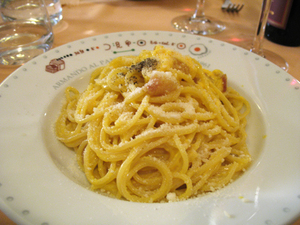 This one’s a bit vague, so bear with me for a second. My first inclination was to tell you to head for the old Jewish ghetto and order yourself a plate of Jewish-style carciofi, or artichokes, which are deep-fried. But as Italian cooking is all about seasonal ingredients, you can only get carciofi in the spring when they’re fresh. That doesn’t mean, however, that there isn’t something wonderful and very Roman for you to enjoy, no matter when you’re there. One of the most popular cheeses in Roman cooking is pecorino romano (makes sense, eh?), and one of the favorite dishes of my many Rome-loving friends is cacio e pepe – a simple pasta dish with lots of pecorino romano and black pepper. Other common Roman pasta dishes, which you may be familiar with from restaurants outside Italy but should try in the place where they come from, are bucatini all’amatriciana (a tomato sauce cooked with onion and a fatty pork called guanciale) and spaghetti alla carbonara (the sauce is made from egg yolks, pecorino romano, and pancetta). In short, get yourself a copy of “The Hungry Traveler” before your trip so you know what’s local, and sample liberally.
This one’s a bit vague, so bear with me for a second. My first inclination was to tell you to head for the old Jewish ghetto and order yourself a plate of Jewish-style carciofi, or artichokes, which are deep-fried. But as Italian cooking is all about seasonal ingredients, you can only get carciofi in the spring when they’re fresh. That doesn’t mean, however, that there isn’t something wonderful and very Roman for you to enjoy, no matter when you’re there. One of the most popular cheeses in Roman cooking is pecorino romano (makes sense, eh?), and one of the favorite dishes of my many Rome-loving friends is cacio e pepe – a simple pasta dish with lots of pecorino romano and black pepper. Other common Roman pasta dishes, which you may be familiar with from restaurants outside Italy but should try in the place where they come from, are bucatini all’amatriciana (a tomato sauce cooked with onion and a fatty pork called guanciale) and spaghetti alla carbonara (the sauce is made from egg yolks, pecorino romano, and pancetta). In short, get yourself a copy of “The Hungry Traveler” before your trip so you know what’s local, and sample liberally. - Do Some People-Watching at the Trevi Fountain
 I admit that the Trevi Fountain is seriously touristy, and can even be kind of a pain in the you-know-what to visit in the height of the tourist season because of the crowds. But if your agenda at the fountain isn’t the same as everyone else’s, then it’s not as much of a pain. See, if you’re intent on clawing your way through the hordes to throw your coin in the water (right hand over left shoulder, remember!), then you’ll get annoyed by the sheer number of humans milling about taking pictures and silly videos. But if you can skip the ceremonial coin-toss, then you can just relax, hang out, and watch the throngs of people repeating the same ritual over and over again. It gets pretty amusing, actually – especially when the designated photographer or videographer goofs up and the whole process has to be repeated (there goes another euro!). I do suggest that if you’re taking this opportunity to slurp down some gelato that you bring your cone or cup from elsewhere, as the gelaterie around the fountain are overpriced and not as good as you can find in other nearby neighborhoods.
I admit that the Trevi Fountain is seriously touristy, and can even be kind of a pain in the you-know-what to visit in the height of the tourist season because of the crowds. But if your agenda at the fountain isn’t the same as everyone else’s, then it’s not as much of a pain. See, if you’re intent on clawing your way through the hordes to throw your coin in the water (right hand over left shoulder, remember!), then you’ll get annoyed by the sheer number of humans milling about taking pictures and silly videos. But if you can skip the ceremonial coin-toss, then you can just relax, hang out, and watch the throngs of people repeating the same ritual over and over again. It gets pretty amusing, actually – especially when the designated photographer or videographer goofs up and the whole process has to be repeated (there goes another euro!). I do suggest that if you’re taking this opportunity to slurp down some gelato that you bring your cone or cup from elsewhere, as the gelaterie around the fountain are overpriced and not as good as you can find in other nearby neighborhoods. - Visit Another Church in Rome
 If you’re reading the title for #9 with an eyebrow raised, I don’t blame you. I’m cheating a little bit with this one, but I’ve got a good reason for it. Most people I know make plans to see St. Peter’s Basilica in the Vatican during a visit to Rome, but many people overlook all the other fantastic churches in this church-heavy city. (And I know that technically the Pantheon is still a church, but I don’t count it as such for these purposes.) Rather than just suggest one of them, however, I’m suggesting that you find at least one other church that sounds or looks interesting to you and make it a point to visit it. Many of the churches in Rome house works of art by masters, artists whose names you know, and there’s often no fee to get in, so it’s a bargain traveler’s dream, too. Santa Maria del Popolo has two Caravaggio paintings, Santa Maria della Vittoria has Bernini’s “St. Teresa in Ecstasy,” San Carlo alle Quattro Fontane was designed by Borromini, San Pietro in Vincoli has a Michelangelo statue of Moses, Santa Maria in Trastevere is one of the city’s oldest churches, San Luigi dei Francesi has three Caravaggios, Santa Maria alla Minerva is the only Gothic church in Rome… The list goes on and on. At the very least, poke your head inside any church you see that looks even vaguely interesting – you might end up finding what is, to you, a hidden Roman treasure. And that’s one of the best things that can happen when you travel.
If you’re reading the title for #9 with an eyebrow raised, I don’t blame you. I’m cheating a little bit with this one, but I’ve got a good reason for it. Most people I know make plans to see St. Peter’s Basilica in the Vatican during a visit to Rome, but many people overlook all the other fantastic churches in this church-heavy city. (And I know that technically the Pantheon is still a church, but I don’t count it as such for these purposes.) Rather than just suggest one of them, however, I’m suggesting that you find at least one other church that sounds or looks interesting to you and make it a point to visit it. Many of the churches in Rome house works of art by masters, artists whose names you know, and there’s often no fee to get in, so it’s a bargain traveler’s dream, too. Santa Maria del Popolo has two Caravaggio paintings, Santa Maria della Vittoria has Bernini’s “St. Teresa in Ecstasy,” San Carlo alle Quattro Fontane was designed by Borromini, San Pietro in Vincoli has a Michelangelo statue of Moses, Santa Maria in Trastevere is one of the city’s oldest churches, San Luigi dei Francesi has three Caravaggios, Santa Maria alla Minerva is the only Gothic church in Rome… The list goes on and on. At the very least, poke your head inside any church you see that looks even vaguely interesting – you might end up finding what is, to you, a hidden Roman treasure. And that’s one of the best things that can happen when you travel. - Browse the Campo dei Fiori Markets
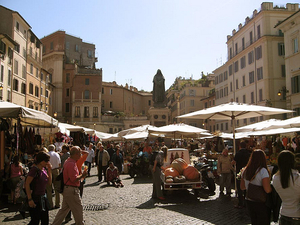 Every Italian city has an outdoor market where you can buy foodstuffs, and cities the size of Rome have several. But the one that’s worth your time to visit is the market at Campo dei Fiori. It’s not far from the famous Piazza Navona, and while the name means “field of flowers” it’s been the setting for a daily morning food market since the mid-1800s. Far from being just a tourist attraction, the market at Campo dei Fiori – like nearly all Italian food markets – is where locals come to stock their kitchens. If you’re staying in a hostel in Rome or have an apartment rental with a kitchen, you can peruse the offerings and buy what you need to cook your own meal. If you don’t have a kitchen at your disposal, don’t worry – you can still interact with the vendors by purchasing the makings of a lovely picnic lunch. The market is only in the piazza in the mornings, so you can’t sleep in or you’ll miss it. And don’t forget to read up on all the market rules you’ll need to know before you buy.
Every Italian city has an outdoor market where you can buy foodstuffs, and cities the size of Rome have several. But the one that’s worth your time to visit is the market at Campo dei Fiori. It’s not far from the famous Piazza Navona, and while the name means “field of flowers” it’s been the setting for a daily morning food market since the mid-1800s. Far from being just a tourist attraction, the market at Campo dei Fiori – like nearly all Italian food markets – is where locals come to stock their kitchens. If you’re staying in a hostel in Rome or have an apartment rental with a kitchen, you can peruse the offerings and buy what you need to cook your own meal. If you don’t have a kitchen at your disposal, don’t worry – you can still interact with the vendors by purchasing the makings of a lovely picnic lunch. The market is only in the piazza in the mornings, so you can’t sleep in or you’ll miss it. And don’t forget to read up on all the market rules you’ll need to know before you buy.
I’ve left one relatively popular spot off of this list – the Spanish Steps – because I find it kind of ho-hum, personally. If the people-watching listed at #8 above was especially fabulous to you, however, the next logical place to do more is at the Spanish Steps – there’s nothing to do there but sit and watch the flow of humanity anyway. But because it’s such a popular tourist attraction, and because visitors tend to be preoccupied with people-watching, it’s also a great place to hang out if you’re a pickpocket. As long as you’ve got your valuables safely tucked away, you should be fine.
>> Check out more things to do in Rome
>> Learn the things you should know about Rome
original photos: top Trevi picture by hyunlab, Roman Forum picture by Ramiro Sanchez-Crespo, Colosseum floor by vgm838, Trastevere piazza picture by James.Stringer, Cappuchin Crypt picture from official website, spaghetti alla carbonara picture by exile in suburbia, Santa Maria del Popolo picture by vgm8383, Campo dei Fiori picture by once&future, and all other pictures by Jessica Spiegel (and may not be used without permission)
[display_feed=https://www.italylogue.com/tag/rome/feed;title=Other articles about Rome;items=10;desc=0]